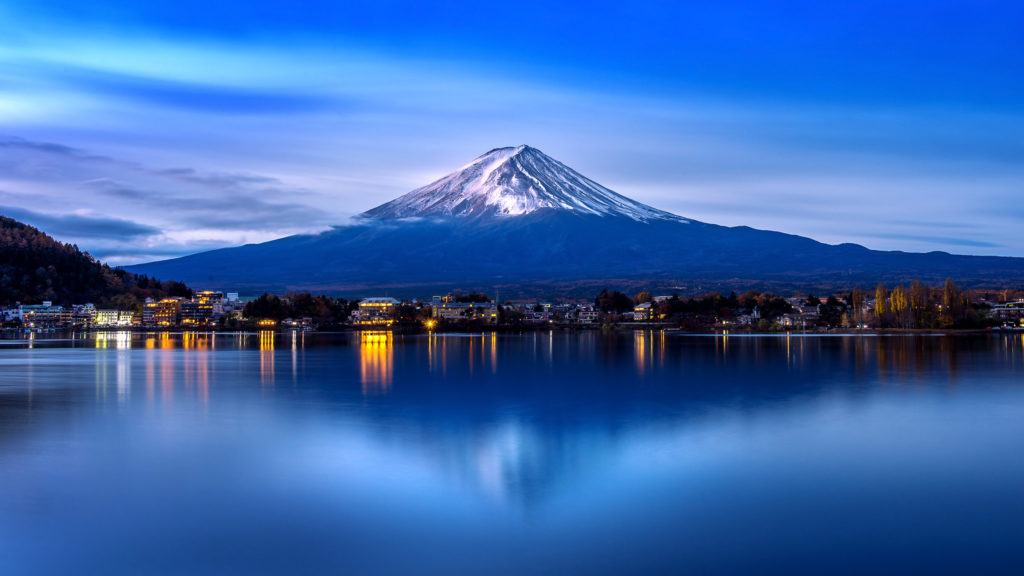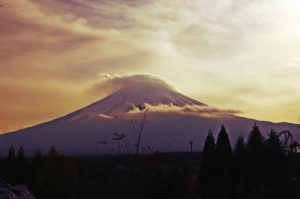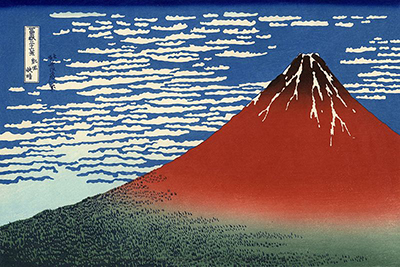
Mount Fuji and the Goddess Sengen-Sama
Mount Fuji (富士山 Fujisan) is a staggering 12,389 feet high: the tallest mountain in Japan. Located on Honshu Island, it can be seen all the way from Tokyo on a clear day. Mount Fuji is famous for its near perfect cone shape, surrounding national parks and lakes, and is one of the “Three Holy Mountains” (三霊山 Sanreizan), along with Mount Haku and Mount Tate. Thousands of pilgrims and tourists brave the climb to the summit of Mount Fuji every August to pay homage to the shrine of the Shinto goddess Sengen-Sama and attend the traditional Japanese festival of fire “Fujijoshida”, the most important event of the summer season at Fuji.
Mount Fuji is an active volcano that has inspired artists for hundreds of years. After the 1600s, when Tokyo (then called Edo) became the capital of Japan, more and more people were able to view the magnificent mountain while travelling along the Tōkaidō-road. Some of the more popular works of art include Hokusai’s “36 Views of Mount Fuji” and “100 Views of Mount Fuji”. Many Japanese poets and writers have also been inspired by the beauty of the cone-shaped mountain.
Mt. Fuji. | Emily Cole
Avid mountain climbers love the challenge of conquering Mount Fuji’s peak. The summit was considered sacred and women were not allowed to make the climb until the Meiji Era. The first person to reach the top of Mount Fuji was an anonymous monk. The very first foreigner to climb Mount Fuji was Sir Rutherford Alcock on September of 1868, followed by the first foreign woman, Lady Fanny Parkes, a year later. Ancient Samurai also used the lower regions of Mount Fuji , near present day Gotemba, as a training ground.
Buddhists believe that Mount Fuji rose from the earth in 286 BC during an earthquake which also formed the largest lake in Japan, Lake Biwa (also considered a gateway to another world).
Shinto religion teaches that the mountain is sacred to the goddess Sengen-Sama, also known as Konohanasakuya-hime or Kono-hana. According to Japanese mythology, Konohananosakuya-hime is the blossom-princess and her symbol is the cherry blossom (sakura) which embodies delicate earthly life. She is the daughter of the mountain god Ohoyamatsumi (Oho-Yama), and the wife of the god Nigini.
South Wind, Clear Sky (Gaifū kaisei) by Hokusai. Part of the series, Thirty-six Views of Mount Fuji, no. 33.
As the story goes, Kono-hana met Nigini by the shores of the ocean and quickly fell in love. Nigini sought the blessing of Oho-Yama to marry Kono-hana. Oho-Yama initially offered the hand of his elder daughter, Iwa-Naga, the rock-princess, but Nigini refused because he was madly in love with Kono-hana. Seeing how determined Nigini was to marry Kono-hana, Oho-Yama soon relented and agreed to give his blessing for the union.
Shortly after the marriage, Kono-hana became pregnant. This aroused the suspicion of Nigini, prompting him to think that his wife was carrying another kami’s seed. Kono-hana was outraged by her husband’s accusation, so she decided to enter a doorless hut that she set on fire. Kono-hana declared that if the child she was carrying truly belonged to Nigini, no harm would come to it. She entered the hut and soon gave birth to three healthy babies—Hoderi, Hoori, and Hosuseri. Today, shrines honoring Kono-hana are found all around Mount Fuji to keep it from erupting.


